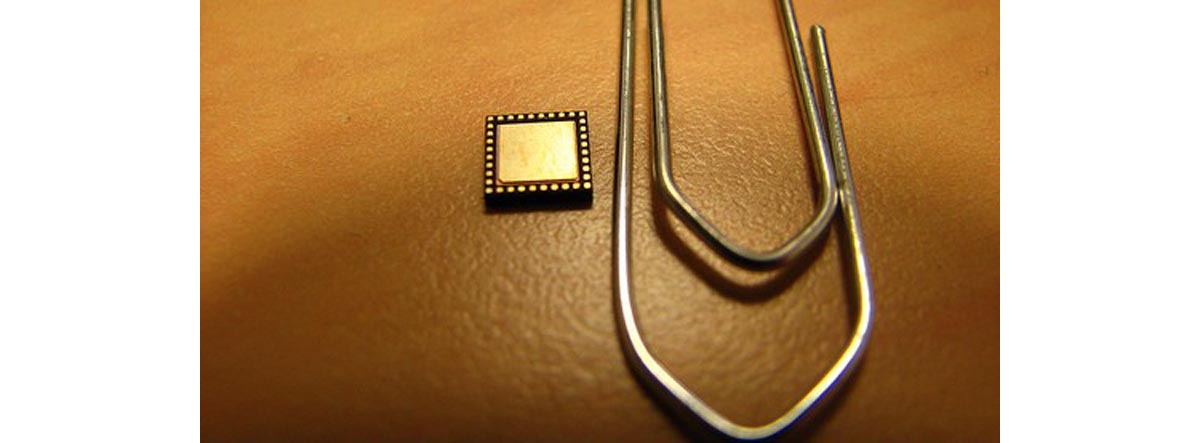Wouldn't it be nice if controlling your appetite so you could take off the weight was as easy as flipping a switch? That's the general idea behind the development of an implantable microchip for the vagus nerve recently announced in Britain.

The Amazing Vagus Nerve
The vagus nerve is the tenth of the twelve paired cranial nerves. It extends from the medulla of the brain downward between the jugular vein and the carotid artery and then down through the neck, chest, and abdomen. Its task is to transmit messages between the brain and the internal organs.
The transfer of information along the vagus nerve is two-way traffic. The brain sends instructions to the internal organs, but the internal organs also send subconscious information to the brain. Unlike, say, the production of stress hormones, the heart and the digestive tract to a certain extent act as if they have a brain of their own, as they generate the feelings that sometimes take precedence over rational thought.
Safety, Security, and Appetite
The anatomy of the vagus nerve is such that, among its other functions, it is particularly stimulated by a hug. In general, any kind of "freezing" behavior is mediated through vagal connections.
Human beings are "pre-programmed" to protect themselves by fight, flight, or freezing in place. Many social connections, however, also involve immobilization. A baby nursing at mother's breast, or friends greeting each other with a hug, or a couple making love, all perform "freezing" behavior controlled, in part, by the vagus nerve. Whether someone is eager to hug or shies away from a hug (or sex) depends in part in how the vagus nerve is "toned."
Food Is a Hug from the Inside Out
Filling up the stomach is analogous to a hug from the inside out. The vagus nerve tells us whether it's "safe" to get the "hug" from eating our fill, or whether a meal should be avoided. Changing the strength of vagal nerve activity, therefore, stimulates or interferes with appetite.
Physicians have known for at least 20 years that installing various kinds of electronic vagal pacemakers on the vagus nerve could help patients with uncontrollable eating disorders. The latest innovation from the UK, however, is a pacemaker in the form of a tiny electronic chip that does not require complicated surgery to install.
The new microchip technology involves attaching the chip to the vagus nerve in the abdomen with cuff electrodes. It's a far less invasive and less expensive procedure than gastric bypass surgery, and because it regulates feeling of fullness rather than the size of the digestive tract, it allows normal production of the intrinsic factor that helps the body absorb vitamin B12 and normal absorption of vitamins and minerals.
Are You A Candidate For A Vagus Nerve Microchip?
Could the vagus nerve microchip be the answer to your weight loss goals? Only your doctor will know for sure, but here are some important considerations.

- The newly announced microchip is not the only device that has been used to help regulate the vagus nerve so patients can lose weight. Other kinds of surgically implanted pacemakers have been used in weight control (almost always for people who are seriously obese, with BMIs between 35 and 50) since the 1990's.
- With the older vagal stimulation technology, weight loss in the six months after surgery has been 14 to 23%. There are not enough data to generalize results of the new chip technology, but it is likely that the microchip will get similar results.
- Most of the weight loss when appetite reduction is achieved by stimulating the vagus nerve comes from body fat, rather than muscle.
- Most people who are implanted with devices to stimulate the vagus nerve report diminished appetite for sweets.
However, there is also a potential downside to using vagal nerve stimulation, sometimes referred to as VNS, for weight loss:
- There haven't been any definitive studies that confirm that people treated with the device keep weight off long-term.
- There are occasional side effects from implantation of the older devices, such as hoarseness, coughing, alteration of the voice, throat pain, snoring, shortness of breath, nausea, vomiting, and infection. The older approach, however, involved implantation of the device in the chest, while the new microchip is implanted in the abdomen.
- The newer weight loss chip does not directly stimulate the vagus nerve. Instead, it sends signals to the brain when it detects changes in activity in the vagus nerve. Less is known about the long-term results of microchip implantation than about the older VNS technology.
And you won't be able to get the new microchip at all in the USA until the FDA approves it, and health insurance companies will balk at coverage. However, the older VNS technology is already covered by most health insurance policies and by Medicare.
For some people who have struggled with weight control for their whole lives, however, vagal nerve stimulation is almost a miracle. Appetite is switched off without stapling the stomach or injecting Botox into the belly or surgically removing parts of the stomach through an inherently risky surgical procedure. The results of VNS are just as fast as those from gastric bypass and come with far less risk. Only you and your physician, however, ultimately can decide if vagal nerve stimulation therapy is for you.
- Sarr MG, Billington CJ, Brancatisano R, Brancatisano A, Toouli J, Kow L, Nguyen NT, Blackstone R, Maher JW, Shikora S, Reeds DN, Eagon JC, Wolfe BM, O'Rourke RW, Fujioka K, Takata M, Swain JM, Morton JM, Ikramuddin S, Schweitzer M, Chand B, Rosenthal R
- EMPOWER Study Group. The EMPOWER study: randomized, prospective, double-blind, multicenter trial of vagal blockade to induce weight loss in morbid obesity. Obes Surg. 2012 Nov.22(11):1771-82. doi: 10.1007/s11695-012-0751-8.
- Verdam FJ, Schouten R, Greve JW, Koek GH, Bouvy ND. An update on less invasive and endoscopic techniques mimicking the effect of bariatric surgery. J Obes. 2012
- 2012:597871. doi: 10.1155/2012/597871. Epub 2012 Aug 21.
- Photo courtesy of fdecomite on Flickr: www.flickr.com/photos/fdecomite/8157597343
- www.medicaldaily.com/articles/14452/20130329/researchers-vagus-nerve-microchip-implant-obesity-weight-loss.htm#YCv1cXvIbh97i5Yq.99
- www.prnewswire.com/news-releases/cyberonics-inc-announces-first-clinical-patient-implanted-in-pilot-clinical-study-of-vagus-nerve-stimulation-vnstm-for-obesity-72737347.html


Your thoughts on this